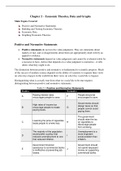Class notes
Study Notes for 1st year Intro to Microeconomics course
- Institution
- Saint Mary’s University (StMU )
These study notes include detailed information for each chapter in the "Microeconomics, Christopher Ragan, 16th Canadian Edition. Pearson" textbook. I used these notes to gain an A+ for the course.
[Show more]




